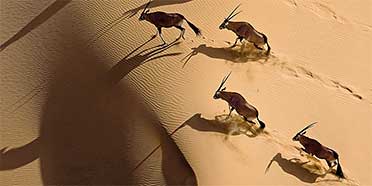
 US
US
Mary is an acclaimed travel writer and author of many Lonely Planet guidebooks, including South Africa, Tanzania, East Africa and Africa.
1 person found this review helpful.
Rewarding Wildlife Watching in an Unforgettable Setting
Going on safari in Namibia is a case where the setting takes first place while the wildlife comes as an unexpected bonus. From the soaring orange dunes of Sossusvlei to the desolate grandeur of Fish River Canyon and the breathtaking drama of cold Atlantic waves crashing onto barren desert sands, Namibia’s scenery is unforgettable. Cloudless blue skies arc high above by day, while night skies are filled with swirling galaxies, brilliant planets and more stars than can be imagined. Throughout, the overwhelming impression the country leaves is one of unparalleled space and solitude.
Thanks to Namibia’s good tourist infrastructure and its extensive network of generally well-maintained roads, it is an ideal self-drive destination and an easy introduction to the continent. In addition to almost guaranteed animal spotting at Etosha National Park, Namibia’s main park, there are so many other places that offer unexpected wildlife encounters. These include Damaraland, with its desert-adapted elephants, lions and rhinos; the Zambezi region in the far northeast, where hippos and crocs inhabit meandering waterways; the coast, with its flamingos, pelicans and Cape fur seals; and Namibia’s vast inland stretches, where a chance encounter with a solitary oryx can transform the landscape.

Dale is a multi-award-winning writer and photographer with more than 500 published magazine articles featured in magazines such as National Geographic, BBC Wildlife, Travel Africa, and CNN Travel.
2 people found this review helpful.
Endless Vistas, Wildlife, Culture & Very Big Skies
Namibia is a land of grand vistas and big skies; a place where horizons seem farther away than in other countries because, in general, the scenery here is so uncluttered. With a surface area of around 825,000km2 and a human density of just three people per square kilometer, you’ll be hard-pressed to find anywhere else quite so empty.
The anthropologically inclined will enjoy meeting fascinating cultures, such as the Himba and the San Bushmen, whilst wildlife fans will be satiated by sightings of rare and unusual oddities that eke out a living in the deserts and wide-open planes. Lovers of landscapes will most certainly appreciate the dune sea and the vast deserts of the Namib-Naukluft National Park and the aptly named Skeleton Coast, both of which account for almost all of Namibia’s 1,600km of coastline.
Namibia’s landscapes (most of which are breathtaking even outside of the parks) lend themselves to leisurely driving holidays, as do the roads, most of which are in good condition. As such, Namibia has to be one of the best driving destinations in Africa (if not the whole of the world)
There are copious campsites and luxury lodges situated in even the most isolated of areas catering to both those who like a bit of luxury and those who prefer setting up their own tent and cooking on an open fire.
It’s a country for all budgets.
I love Namibia because it’s so very different from just about anywhere else in sub-Saharan Africa, and although there are plenty of opportunities to see the big five (especially at parks such as Etosha or up on the Waterberg Plateau), you’ll also get to experience massive deserts, endless grasslands, and mountains that have been stripped bare by the harsh heat.
There are swaths of this mostly arid country that will make you think you have traveled to Mars.
Highlights include being able to track desert-adapted black rhinos on foot, flying in a small airplane across a pre-dawn misty desert, spending time with the beautiful red-hued Himba people, watching lions make a kill at a waterhole in Etosha, seeing seals at play on the coast, and enjoying authentic German eisbein and beer at the colonial town of Swakopmund.
If you’ve never been to Namibia, then go! You’ll love it. And if you’ve been there before, well, go again. There’s so much variety, originality, and wonderful locations and activities on offer in this big, beautiful nation that you’ll likely never see the same thing twice.

Lizzie is a reputed guidebook writer and author of the Footprint guides to South Africa, Namibia, Kenya, Tanzania, Uganda and Zimbabwe.
6 people found this review helpful.
Unspoilt wilderness and unique and stunning landscapes offering a variety of contrasting safari expe
A hauntingly beautiful country that stretches along the west coast of southern Africa, with wide open spaces, big skies and some of the earth's most mystical and vivid sunsets, any visitor is blown away by the way Namibia ‘looks’ – the landscapes here are totally different to any other African country. As one of my favourite destinations, I have an endless list of why it appeals so much, but I think overall its Namibia’s unconfined space, silence and extremes that make it so interesting – it’s literally exposed to the mercy of the elements and how the flora and fauna, even the littlest things like insects and plants, and in some regions the people, survive in such an inhospitable environment is fascinating to see. It features a brutally hot climate, shimmering sun soaked plains, rugged mountains, great canyons, barren red-sand deserts, and a furiously wild coast.
I find it an incredibly rewarding safari destination – not just for animals (which, while they are numerous in their diversity, are less in concentrations than other southern African regions) but for its fascinating variety of habitats. Most types of big game can be found in the parks and reserves such as Etosha, including a number of rare species, and even in the desert you'll find elephant, rhino, and numerous antelope. The birdlife too is magnificent, especially so in the well-watered fertile finger-like Zambezi Region which is nothing like the rest of the country’s arid landscapes.
While the official tourist hot spots are spread all over the map, it has a fully developed infrastructure an impressively organized tourism industry with an excellent choice of accommodation and activities. Despite its vastness, I also find its geographical location is a bonus too; it provides an ideal addition to visits to South Africa and Botswana, and where the Caprivi ends in the east, the traveller is within a stone's throw of the mighty Victoria Falls.

Christopher is a British travel writer and has contributed to various Fodor's guidebooks and a range of travel magazines.
9 people found this review helpful.
Sand, salt pans and stars: Southern Africa’s wild west
With the exception of the verdant Zambezi Region, most of Namibia is comprised of harsh and inhospitable desert, but I’ve always found it staggeringly beautiful. Namibia was the first place I really travelled in Africa; I’ve been back many times since, and it will always hold a special place in my heart.
Etosha National Park is one of the most popular and accessible Big 5 wildlife areas on the continent. In the bone dry winter months, the waterholes become a veritable carnival of wildlife. On my last visit, I counted 200 animals across 15 species at a single waterhole before my counting was interrupted by two young male lions storming into the midst of it all and causing a scene of absolute pandemonium.
Although Namibia has experienced a spike in poaching of its elephants and rhinos in recent years, the country enshrines wildlife conservation in its constitution and both the government and the private sector have invested considerable time and money in the development of ethical and eco-friendly tourism. Many of the private game lodges and wildlife areas also directly benefit local communities.
Given the unforgiving environment, it’s not surprising that wildlife density is not as great in most of Namibia as in some other countries in the region. But, here you can have the unique opportunity of seeing rare desert elephants, and perhaps the even rarer desert-dwelling lions. Namibia also has the highest population of free-roaming black rhino in Africa.
What Namibia might lack in wildlife density, it more than makes up for in wide open spaces, incredible vistas and big starry skies. Standing on the top of the great dunes of Sossusvlei at sunrise or sunset will always be an unforgettable experience for me, and a tour around the strange and ghostly abandoned diamond mining town of Kolmanskop is another personal favourite.
Tha aptly-named Skeleton Coast (so-called for the numerous shipwrecks that can be found here) is a hub of interesting marine life, and the incongruous coastal town of Swakopmund is an adventure enthusiast’s dream. The lush Zambezi Region, formerly the Caprivi Strip, offers a quieter alternative to Botswana’s Chobe National Park, with some excellent riverine accommodations, game viewing and activities.

Mike is an award-winning wildlife writer, former editor of Travel Zambia magazine and author of the Bradt Guide to Southern African Wildlife.
10 people found this review helpful.
Harsh beauty
Namibia breaks the mould. Its rugged rock and desert landscapes provide a quite different backdrop – and thus different visitor experience – from any other African safari destination. For many, the country’s attractions are as much about the scenery as the wildlife. Certainly, I was taken aback by the sheer power of the landscape on my first visit, and the excitement of camping under the stars in a genuine wilderness ¬– from the huge dunes of the Namib Desert to the sculptured rock formations of Damaraland – left an indelible impression.
Nonetheless, the wildlife enthusiast will still find plenty to get excited about. Etosha is undoubtedly one of Africa’s top ten game parks, with its huge dry season concentrations of game – and abundant predators – creating some of the best waterhole spectacles on the continent. Big game also occurs in smaller numbers elsewhere in the north, from the Zambezi Region, the one area of the country with enough water to support species such as hippo and buffalo, to the Kaokoveld, where desert-adapted black rhinos and elephants are a unique attraction. And it’s not all about big game: the arid landscapes are home to numerous lesser-known species that are hard or even impossible to find elsewhere, from brown hyena to shovel-snouted lizard. Birders can pursue endemics, such as dune lark and Rüppell’s korhaan, and enjoy the great water bird spectacles of the coast, where flamingoes, pelicans, cormorants and others flock in huge numbers to sites such as Walvis Bay.
Roughly 15% of Namibia is protected within reserves, and the healthy tourist infrastructure ranges from simple national park accommodation to upmarket lodges. Specialist activities such as balloon rides and bushman tracking aim to make the most of the desert experience. Despite its rugged landscapes, the country has a good transport network and is an excellent destination for the independent, self-drive traveller. And you don’t have to be a wilderness pioneer: I was amazed at how far you can take a simple family car – just so long as you plan your petrol stops in advance.

Anthony is a photographer and writer for travel magazines and Lonely Planet, including the guides to Kenya and Botswana & Namibia.
12 people found this review helpful.
Namibia: Wildlife & Landscapes
If you reduce the appeal of Namibia to its essence, it would be this: Namibia is one of the most beautiful countries in Africa and the wildlife here is spectacular.
If you were to choose a beautiful backdrop for your African safari, you’d be hard-pressed to improve on Namibia. If you’ve ever dreamed of sand dunes soaring high over the ocean’s waves, Namibia has that covered. So, too, Fish River Canyon, ‘Africa’s Grand Canyon’ and one of the continent’s most arresting sights this side of the Rift Valley. And then there’s the Kalahari. Or the salt pans of Etosha.
But there’s so much more to the country than these well-known landscapes. The rocky spine that traverses the heart of the country takes in some extraordinary landforms. Spitzkoppe, Twyfelfontein and Brandberg are dramatic in scale and beauty but shelter in their rocky clefts some extraordinary examples of millennia-old rock art. Further north, Damaraland is a strange and wildly pretty corner of the country with red earth and great boulders. Then there’s the Zambezi Region (Caprivi Strip), Namibia’s little-known echo to neighbouring Botswana’s Okavango Delta, with rivers, watery expanses and floodplains rich in predators and prey.
For all such beauty, if it’s wildlife that brought you here, then Namibia can promise that, too. Etosha is the most obvious places to begin, one of Africa’s elite national parks with staggering wildlife populations. But highlights are many elsewhere – the parks of the Zambezi Region could be Africa’s next big safari destination, while Damaraland with its rhinos and desert elephants and desert lions is Southern Africa’s best-kept secret. With African wild dogs in Khaudum National Park and more cheetahs than any other country on earth, Namibia is a fantastic place to go on safari.

Emma is an award-winning travel writer for Rough Guides, National Geographic Traveller, Travel Africa magazine and The Independent.
19 people found this review helpful.
A place to bond with the desert and marvel at the stars
It’s rare for travellers to return from Namibia with anything other than glowing praise. I’m always impressed by the spacious drama of its desert landscapes, where oryx pick their way over towering, apricot-coloured dunes or stare out from under solitary camelthorn trees, ostriches dash through the shimmering haze and desert-adapted elephants lumber along dry river beds. At dusk, the air reverberates with the chinking call of geckos as Namibia’s huge skies mould themselves into a dizzying dome of stars.
Best of all, these splendours are accessible – while you might feel apprehensive about venturing into the trackless Sahara, Namibia’s great desert regions are loosely crisscrossed with decent gravel roads, making it easy enough to explore.
Sparsely populated, but with enough mineral wealth to make it one of Africa’s more prosperous countries, Namibia, though somewhat troubled by land reform issues, is largely a model of peace, stability and inter-ethnic respect. I’ve always felt very comfortable here. If you’re self-reliant and confident behind the wheel of a 4x4, you need feel no qualms about travelling totally independently, staying at simple campsites or fabulously designed bush lodges as you go.
Organised adventures are available, too, and feature some of Africa’s rarer experiences, such as spending time with Ju’Hoansi Bushmen, whose ancestors marked rock faces in the northern semi-desert with engravings of giraffes and antelopes, possibly as a wildlife primer for youngsters. You can also explore one of Africa’s loneliest coasts, track black rhinos through the semi-desert on foot, or get close to big cats in rescue centres. Some of these activities are ground-breaking in that they’re made possible through the conservancy system, whereby traditional rural communities taking a decisive role in environmental and cultural conservation. For more animal action and superb birdwatching, the busy waterholes of Etosha National Park and the riverine wilderness of the Zambezi Region, Namibia’s green lung, definitely deliver.







